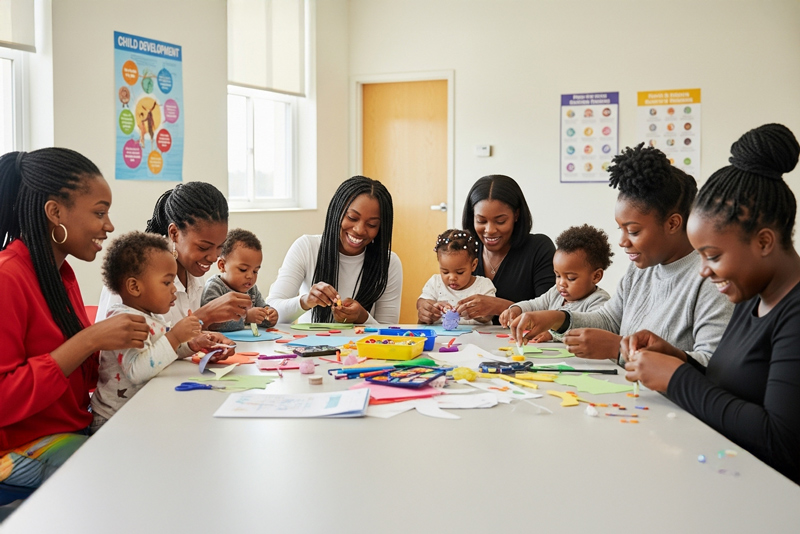According to the 2023 National Survey on Drug Use and Health, 70.5 million people used illicit drugs in the past year, and 48.5 million of them met the criteria for a substance use disorder (SUD). In 2022, 32.6 million women reported illicit drug use, and while men have historically shown higher SUD rates, women with addictive disorders often face greater vulnerability (Fonseca et al., 2021). Nearly 16.4 million women with an SUD did not receive treatment because they did not believe they needed it, and only 15.2% of those diagnosed received any form of care (SAMHSA, 2022). These numbers underscore the deep impact of isolation from support and the need to remove barriers to treatment access for women. Fonseca et al. (2021) and Rizzo et al. (2022) highlight systemic, structural, and personal-level challenges—especially addiction stigma—as major obstacles to care. Women often face heightened stigma, more severe social consequences, and additional barriers such as poverty, co-occurring mental illness, and the lack of gender-responsive services. Family responsibilities, fear of legal repercussions, and child welfare concerns further complicate access. Given this complexity, a family-centered, gender-specific residential treatment model may offer an ideal approach to addressing the unique needs of women with substance use disorders.

I am writing as the Program Director at the Samaritan Daytop Village Young Mothers Program (YMP), a residential addiction treatment program where women can live with their young children while working on their recovery. The program is a supportive, structured environment that provides multi-faceted programming to combat alcohol and drug addiction while simultaneously providing prenatal, maternal, and pediatric health care, and adult psychiatric care. Clients have access to individual therapy and case management, attachment and bonding therapy with their children, family therapy, and evidence-based group counseling. Counseling frameworks utilized in the program include Motivational Interviewing, Cognitive Behavioral Therapy, and Dialectical Behavior Therapy, and integrate Community As Method, Trauma Informed Care, and Family Systems Theory. Individuals are often mandated to treatment and find themselves at YMP from a variety of legal systems that include criminal, treatment, or family courts, probation or parole, and child welfare agencies.
Unfortunately, family court referrals to YMP are typically facilitated only after the identified mother has been noncompliant with less-restrictive treatment mandates, and the substance use escalates or continues without resolve, and the legal system then recommends the removal of the child from the care of their parent and frequently begins court proceedings to terminate parental rights. Court-mandated mothers are oftentimes not referred for residential placement until their circumstances have become dire enough to warrant child removal and termination of parental rights proceedings. The removal of the child from the family system because of substance use perpetuates stigma, shame, fear, and feelings of worthlessness. These feelings often underlie an individual’s decision to continue to use substances rather than seek treatment. The removal of the child before the recommendation for residential placement creates desperation and feelings of failure. For those who do elect to seek treatment, the removal creates additional barriers to treatment engagement and family reunification.
Oftentimes, parenting women afflicted by substance use disorder conceal, under report, and minimize their substance use and need for treatment for fear of triggering child protective service investigations and, as a result, continue to parent in dangerous or high-risk situations. The stigma around substance using parents seeking care that results in underreporting then feeds the escalation of addiction and typically contributes to worsening circumstances for their child, and by the time child welfare agencies are involved, the only legal option as it relates to prioritizing child safety is the recommendation to remove the child from the parent’s care.
Between 2007 and 2017, parental drug use-related child removals in the U.S. rose by 60%, largely driven by the opioid crisis (Sieger, 2020), with up to 79% of children in foster care having experienced some level of parental substance use. Children from such families face increased risks of maltreatment, foster care entry, placement instability, and permanent separation from their parents. Reunification is less likely, especially without access to high-quality, culturally responsive, family-centered treatment. Family-focused care has been shown to improve both parental engagement and reunification outcomes compared to individual-focused interventions. Skivenes and Tonheim (2019) emphasize that child removals are among the state’s most invasive actions, usually court-decided, and call for systemic reform, including earlier intervention and better resourcing of child welfare agencies. Similarly, Buek and Mandell (2023) highlight the burden prenatal substance exposure places on the child welfare system and advocate for prevention-focused, community-based responses over punitive court-driven actions. In many states, including New York, opportunities exist to support pregnant people before birth. Peddireddy et al. (2022) note that inconsistent policies across states contribute to racial disparities and biased outcomes, calling for comprehensive support, such as family-centered SUD treatment, mental health services, and help with basic needs
Two consistent interventions are recommended to reduce child welfare involvement and family separation caused by SUD: shifting toward preventive care strategies and increasing funding for family-centered services and child welfare supports. Rather than reacting after maltreatment has occurred, prevention aims to address risks earlier and keep families intact. To be effective, this requires systemic reform that extends across local, state, and federal levels and addresses longstanding structural barriers and biases in child welfare. While the opioid crisis intensified child removals, these systemic issues have existed long before, and addressing them demands collaboration between healthcare, social services, criminal justice, and child welfare systems. Federally, the Child Abuse Prevention and Treatment Act (CAPTA) and the Comprehensive Addiction and Recovery Act (CARA) require states to define child maltreatment and mandate notifications for substance-affected infants. In New York, the Family First Prevention Services Act allows for federal funds to support preventive, evidence-based services like SUD treatment and kinship foster placements. The Family Court Act provides legal procedures for intervention when a child’s needs are unmet.
Currently, most child welfare interventions related to SUD begin with a report from a mandated reporter, followed by investigation, assessment, and, if substantiated, treatment recommendations. If a child is found to be at immediate risk or if caregivers fail to comply with services, removal occurs, followed by court-ordered steps toward reunification. These may include parenting classes, SUD treatment, testing, mental health care, housing referrals, and supervised visitation. However, outcomes remain poor: children removed due to parental SUD are less likely to reunify and more likely to re-enter care (Sieger, 2020). This suggests that court-based, individual treatment responses often fail to resolve underlying systemic issues. Research urges a shift to prevention—providing intensive, in-home support and family-based residential care when needed. Increasing early access to care, particularly for pregnant people, offering wraparound services in healthcare and shelter systems, and improving care coordination could dramatically improve outcomes.
To realize the goals of our existing legislation, we must invest in resources that support child safety and family unity. This includes expanding access to family-centered SUD and mental health treatment, housing support, financial assistance, and services that address poverty, employment, and education. Families impacted by SUD need holistic, proactive support, not punitive, reactive systems that separate rather than strengthen. Instead of relying on the legal system to enforce compliance or viewing residential treatment as a last resort, it should be reframed as a preventive, stabilizing intervention. Family-centered residential treatment has the potential to break intergenerational cycles of trauma and substance use, particularly when used early and equitably. The real barrier is not a lack of need, but a lack of access and investment. Today, 14 adult and 25 child beds sit empty in our mother-child program. Ignoring this unmet need undermines both public policy and the well-being of the families we are supposed to protect.
If you are interested in learning more about the Young Mothers Program, please contact Sarah March, Program Director at sarah.march@samaritanvillage.org or (212) 222-5285 x8363. You can learn more about Samaritan Daytop Village at www.samaritanvillage.org.
References
Buek, K. W., Mandell, D.J. (2023). Perinatal health profiles associated with removal from the home and subsequent child protective services report in maltreated infants. Child Maltreatment, Vol. 0(0) 1-13. DOI: 10.1177/10775595221150232.
Fonseca, F., Robles-Martinez, M., Tirado-Munoz, J., Alias-Ferri, M., Mestre-Pinto, J.I., Coratu, A.M. & Torrens, M. (2021). A gender perspective of addictive disorders. Current Addiction Reports, 8: 89-99.
Peddireddy, S.R., Austin, A. E., Gottfredson, N.C. (2022). Factors contributing to level and type of child welfare involvement following prenatal substance exposure: A scoping review. Child Abuse & Neglect, 125. doi.org/10.1016/j.chiabu.2022.105484
Rizzo, D., Mu, T., Cotroneo, S., & Arunogiri, S. (2022). Barriers to accessing addiction treatment for women at risk of homelessness. Frontiers in Global Women’s Health.
SAMHSA. (2023). 2022 National survey on drug use and health: Among females aged 12 or older.
SAMHSA. (2024). Key substance use and mental health indicators in the United States: Results from the 2023 national survey on drug use and health.
Sieger, M.H. (2020). Reunification for young children of color with substance removals: An intersectional analysis of longitudinal national data. Child Abuse & Neglect, 108. doi.org/10.1016/j.chiabu.2020.104664.
Skivenes, M. & Tonheim. M. (2019). Improving decision-making in care order proceedings: A multijurisdictional study of court decision-makers’ viewpoints. Child& Family Social Work 24: 173-182. DOI: 10.1111/cfs.12600.




